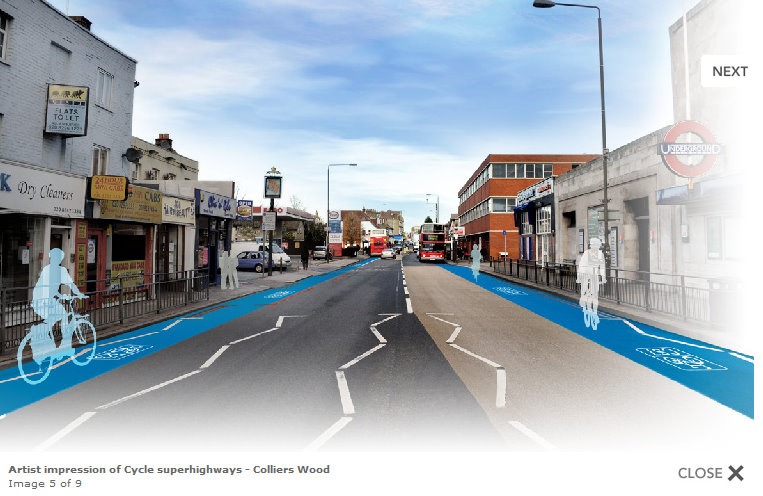
London's 'super' cycle highways are designed for ugliness. The 'artist's impression' shows threatening busses and cyclists who are already ghosts.
‘Highway’ comes from the Old English heiweg “main road from one town to another” and planning them as direct routes from origins to destinations is unusually sensible for UK cycleroute planning. But I object to their being described as ‘super’. They will be narrow, ugly,pale blue, bargain basement tracks. See for example the implementation schedule for the ‘Super Highway’ from Barking to Tower Gateway. The work can be done quickly because it is merely a paint job – and the chosen shade of blue is suspiciously close to that used by the Tory party during its recent election campaign.
A really super cycle highway would be ‘ ‘safe, fast, direct, quiet, clean, beautiful – and expensive’. So they should employ landscape architects, not engineers with paint brushes, to do the work. I worry that badly conceived cycle paths will get little use – so that the planners will then argue that it was a waste of money. They should (1) go ahead with the present plans as a quick stopgap measure (2) design AT LEAST ONE truly excellent cycle route to show what could be achieved.

It seems that adding cycling lanes to the mix will just make an already cramped transportation corridor more cramped and conflicted with different transport users and their needs. Those savy cyclists will need to be very aware of all bus stops on route for example.
A few good examples of creative thinking about cycling might get more imaginative neurons firing:
1. cycle/pedestrian bridge by West 8.
[ http://www.west8.nl/projects/infrastructure/pedestrian_bicycle_bridge_aarschot/ ]
2. danish cycling pavilion in Shanghai.
[ http://www.inhabitat.com/2010/05/03/big-unveils-spiraling-cycling-pavilion-in-shanghai/ ]
Superquick designers might like to submit their ideas to the perfect bike path competition. (ie. registration/submission is by May 28)
[ http://lacompetitionsawards.blogspot.com/2010/04/vejprisen-2010-perfect-bike-path.html ]
ps. Denmark favours blue paint while Australia prefers green. (Perhaps problems with green/red colour blindness is avoided with blue?)
The Times did a feature on the 30 most beautiful Cycle Routes in the UK – but none of them were in towns. So it is probably a good idea to give urban cycle routes a ‘rural’ character.
There is no reason why cycle routes need to follow roadways. Or is there? [ http://www.thewashcycle.com/2010/03/march-2010-dc-bac-meeting-notes-.html ] and [ http://www.pixvee.com/?p=462 ]
For pleasure, it is undoubtedly better if the cycle route does not follow the highway. But (1)origins and destinations are often beside highways (2) cyclists require the most direct routes (3) there is less risk of being assaulted if there are other people around.
The Ciclovia is a useful hybrid. Wiki (with thanks to Eleanor for the link) explains: ‘Ciclovía is a Spanish term, meaning “bike path,” used in Latin America to mean either a permanent designated bicycle route or a temporary event closing of the street to automobiles to allow dominance by other users. Permanent designated bicycle lanes are also known as ciclo-rutas, while streets temporarily closed for that purpose are always called ciclovías. Colombia has the biggest events. Every Sunday and holiday the main streets of Bogotá, Cali, Medellín, and other municipalities, are blocked off for the event to become Carfree. From 7 am to 2 pm, runners, skaters and bicyclists take over the streets.’ Columbia’s reputation as the drugs/murder/kidnapping capital of the Americas lives on – but it has been transformed by good government and good urban design into a delightful city.
The Ciclovia inspired the New York Summer Streets Festival. [ http://www.streetsblog.org/2008/08/11/streetfilms-summer-streets-2008/ ]
Every city should have a Spring Ciclovia.
Under the category of delight I submit the bicycle film festival.
[ http://www.bicyclefilmfestival.com/ ]